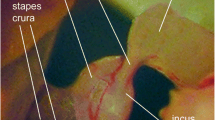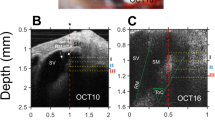Summary
A closed sound field system for independent stimulation of both cricket hearing organs is described. The system was used to measure acoustic parameters of the peripheral auditory system inGryllus campestris and to analyze inhibitory responses of the omega cell, a segmental auditory interneuron in the prothoracic ganglion.
-
1.
Best sound transmission in the tracheal pathway occurs at 5 kHz. Closing of the prothoracic spiracles results in increased sound transmission but does not influence the frequency of best transmission in most animals (Fig. 6 B). Sound transmission is modulated by abdominal contractions associated with the respiratory cycle (Fig. 7).
-
2.
AttenuationΔ and phase shift ϕ in the tracheal pathway have been determined for the frequency range of 2 to 10 kHz in animals with closed spiracles.Δ shows a minimum at 5 kHz and ϕ increases almost linearly with frequency (Fig. 11).
-
3.
Sound components acting on each side of the large tympanal membrane form a resultant sound pressure based on linear superposition. This resultant sound pressure represents the effective stimulus of the auditory sense organ (Fig. 12).
-
4.
The response of the omega cell is dependent upon both intensity and relative phase of sound signals applied to the tympanal membranes (Fig. 10).
-
5.
At 5 kHz, the response of the omega cell decreases linearly with increasing contralateral (inhibitory) stimulus intensity over a wide range of intensities. The latency between stimulus onset and response is nearly independent of contralateral inhibition (Figs. 15 and 16).
-
6.
Response (spike number) differences between an omega cell and its complementary mirror image cell due to different stimulus intensities at both ears are enhanced by the neuronal mechanism of contralateral inhibition. In one animal the gain in spike number difference at 5 kHz was calculated to be 60% relative to the response difference when contralateral inhibition was disabled.
-
7.
Evidence for a low frequency (f≦2 kHz) ipsilateral inhibition of the omega cell is presented (Fig. 17).
Similar content being viewed by others
Abbreviations
- Mi :
-
sound generating microphone in cavityi
- T i :
-
large tympanal membrane of the cricket leg in cavityi
- TO i :
-
tympanal organ of the cricket leg in cavityi
- P i :
-
sound pressure in cavityi
- p i :
-
amplitude ofp i
- L i :
-
sound pressure level corresponding top i
- p :
-
sound pressure acting on the internal side of tympanal membraneT 2
- p :
-
amplitude ofp
- Δ :
-
internal attenuation in the tracheal pathway
- ϕ :
-
internal phase shift in the tracheal pathway
- ΔL :
-
external attenuation used to compensate forΔ
- Δϕ :
-
external phase shift used to compensate forϕ
References
Adams WB (1971) Intensity characteristics of the noctuid acoustic receptor. J Gen Physiol 58:562–579
Boyan GS (1978) Coding of directional information by a descending interneuron in the auditory system of the cricket. Naturwissenschaften 65:212–213
Boyan GS (1979a) Directional responses to sound in the central nervous system of the cricketTeleogryllus commodus (Orthoptera: Gryllidae). I. Ascending interneurons. J Comp Physiol 130:137–150
Boyan GS (1979b) Directional responses to sound in the central nervous system of the cricketTeleogryllus commodus (Orthoptera: Gryllidae). II. A descending interneuron. J Comp Physiol 130:151–159
Casaday GB, Hoy RR (1977) Auditory interneurons in the cricketTeleogryllus oceanicus: physiological and anatomical properties. J Comp Physiol 121:1–13
Esch H, Huber F, Wohlers DW (1980) Primary auditory neurons in crickets: Physiology and central projections. J Comp Physiol 137:27–38
Fletcher NH, Thwaites S (1979) Acoustical analysis of the auditory system of the cricketTeleogryllus commodus (Walker). J Acoust Soc Am 66:350–357
Frederiksen E (1977) Condenser microphones used as sound sources. Brüel and Kjaer Technical Review No. 3
Hill KG, Boyan GS (1976) Directional hearing in crickets. Nature 262:390–391
Hill KG, Boyan GS (1977) Sensitivity to frequency and direction of sound in the auditory system of crickets (Gryllidae). J Comp Physiol 121:79–97
Hoy RR, Casaday GS (1978) Acoustic communication in crickets: Physiological analysis of auditory pathways. In: Burghardt G, Bekoff M (eds), Ontogeny of behavior. Garland Publ, New York, pp 45–62
Johnstone BM, Sounder JC, Johnstone JR (1970) Tympanic membrane response in the cricket. Nature 227:625–626
Kleindienst H-U (1978) Schallbeugung und -reflexion am Grillenkörper im Frequenzbereich 5–20 kHz. Verh Dtsch Zool Ges, 160
Kleindienst H-U (1980) Biophysikalische Untersuchungen am Gehörsystem von Feldgrillen. Dissertation, Rheinische Friedrich-Wilhelms-Universität Bonn
Larsen ON, Michelsen A (1978) Biophysics of the ensiferan ear III. The cricket ear as a four-input system. J Comp Physiol 123:217–227
Lewis DB (1974a) The physiology of the tettigoniid ear I. The implications of the anatomy of the ear to its function in sound reception. J Exp Biol 60:821–837
Lewis DB (1974b) The physiology of the tettigoniid ear II. The response characteristics of the ear to differential inputs: Lesion and blocking experiments. J Exp Biol 60:839–851
Michel K (1974) Das Tympanalorgan vonGryllus bimaculatus De-Geer (Saltatoria, Gryllidae). Z Morphol Tiere 77:285–315
Mörchen A, Rheinlaender J, Schwartzkopff J (1978) Latency shift in insect auditory nerve fibers. Naturwissenschaften 65:565
Nocke H (1974) The tympanal trachea as an integral part of the ear inAcripeza reticulata Guérin (Orthoptera, Tettigonioidea). Z Naturforsch 29c: 652–654
Nocke H (1975) Physical and physiological properties of the tettigoniid (“grasshopper”) ear. J Comp Physiol 100:25–57
Paton JA, Capranica RR, Dragsten PR, Webb WW (1977) Physical basis for auditory frequency analysis in field crickets (Gryllidae). J Comp Physiol 119:221–240
Popov AV, Markovich AM, Andjan AS (1978) Auditory interneurons in the prothoracic ganglion of the cricket,Gryllus bimaculatus DeGeer I. The large segmental auditory neuron (LSAN). J Comp Physiol 126:183–192
Rheinlaender J, Mörchen A (1979) “Time-intensity trading” in locust auditory interneurones. Nature 281:672–674
Schlegel P (1977) Calibrated earphones for the echolocating bat,Rhinolophus ferrumequinum. J Comp Physiol 118:353–356
Schwabe J (1906) Beiträge zur Morphologie und Histologie der tympanalen Sinnesapparate der Orthopteren. Zoologica 50:1–154
Wiese K (1978) Negative Rückkoppelung in der akustischen Bahn vonGryllus bimaculatus als Grundlage temporalen Filterns. Verh Dtsch Zool Ges 168
Wohlers DW (1980) Anatomical and physiological studies of the auditory pathway in crickets. Dissertation, Ludwig-Maximilians Universität München
Wohlers DW, Huber F (1978) Intracellular recording and staining of cricket auditory interneurons (Gryllus campestris L.,Gryllus bimaculatus DeGeer). J Comp Physiol 127:11–28
Young D, Ball E (1974) Structure and development of the auditory system in the prothoracic leg of the cricketTeleogryllus commodus (Walker) I. Adult structure. Z Zellforsch 147:293–312
Zhantiev RD, Kalinkina IN, Tshukanov VS (1975a) The characteristics of the directional sensitivity of tympanal organs inGryllus bimaculatus DeGeer (Orthoptera, Gryllidae). Entomol. Obozr. 54:249–256
Zhantiev RD, Kalinkina IN, Tshukanov VS (1975b) Functional characteristics of two auditory interneurons in the cricketGryllus bimaculatus DeGeer (Orthoptera, Gryllidae). Vestn. MGU Ser Biol 6:18–25
Author information
Authors and Affiliations
Additional information
Supported by the Max-Planck-Gesellschaft
Rights and permissions
About this article
Cite this article
Kleindienst, H.U., Koch, U.T. & Wohlers, D.W. Analysis of the cricket auditory system by acoustic stimulation using a closed sound field. J. Comp. Physiol. 141, 283–296 (1981). https://doi.org/10.1007/BF00609930
Accepted:
Issue Date:
DOI: https://doi.org/10.1007/BF00609930




